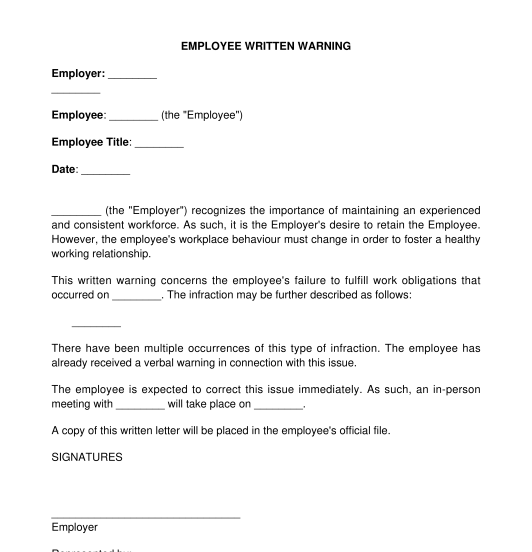 27/02/2025
27/02/2025

Answer a few questions and your document is created automatically.

Your document is ready! You will receive it in Word and PDF formats. You will be able to modify it.

 27/02/2025
27/02/2025
 Word and PDF
Word and PDF
 1 page
1 page
An Employee Written Warning is used when an employer needs to reprimand or warn an employee for a workplace infraction.
Often, an Employee Written Warning is sent after an employer (or someone within the employer's company in a position of authority, such as an HR Manager or Supervisor) has noticed that an employee has been engaging in behaviour that is unacceptable or prohibited, such as:
Yes. Having a written warning is typically required before the employer can reprimand by way of suspension or terminate the employee.
A documented warning is good practice to assist with or prevent any future wrongful termination lawsuits.
The point is to show that the employer has provided warnings before termination.
An Employee Written Warning is merely one of the steps of a progressive disciplinary policy. The written warning usually follows a verbal warning.
A progressive disciplinary policy is a document that lists the series of steps the employer must take to address employee misconduct, starting from simple warnings to outright termination.
The letter must include:
The document also has space for the employee to sign an acknowledgment that the letter was received.
An Employee Written Warning is usually not the first step when an employee engages in problematic behaviour.
An employer is required to provide an employee with feedback about his or her work, especially if there is something that needs to be improved.
Progressive discipline is a term that refers to the ongoing warnings that an employer may issue to an employee about their job performance. For instance, it may start with a verbal warning, followed by a series of written warning if the issue continues. A written warning forms part of the progression stages.
An Employee Written Warning is used to keep an official record of the employee's problematic behaviour. If the employee continues with their non-compliance, an Employee Written Warning may be the first step in the eventual termination of their employment.
Once the document has been filled out, it must be signed by the employer and delivered to the employee. The employer should keep a copy of the warning in the employee's file.
The employer will need to monitor the situation to determine if the employee is complying with the written warning.
If the employee doesn't comply, additional measures may need to be taken, including suspension and possible termination of employment. A work suspension is when the employer temporarily stops the employee from attending at work. Termination is when the employee is fired and no longer works for the employer.
While no laws outline what must be put into an Employee Written Warning, there are, however, some overall accepted practices for creating such documents, including making sure the information is robust enough so that the employee knows what they did wrong and how to correct it. Furthermore, each province and territory has laws and regulations dictating what may be done in the employment context. For example, to terminate an employee for cause, there must be records of progressive discipline. The pieces of legislation governing employment law are as follows:
You fill out a form. The document is created before your eyes as you respond to the questions.
At the end, you receive it in Word and PDF formats. You can modify it and reuse it.
Employee Written Warning - Template - Word & PDF
Country: Canada (English)